The Iron Plate in American Photography 1853 - 1880
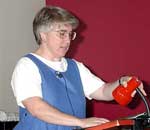 Dr. Janice G. Schimmelman is Chair of the Department of Art and Art History at Oakland University, Michigan. She was joined by her husband, John Cameron at our June 20th meeting. Janice began collecting tintypes seven years ago while accompanying her husband on his search for glass plate stereo images. Her casual collecting based on the low cost of the images shifted three years ago to a more scholarly interest in the history of the tintype and how to determine the age of the images. Following is a brief recap of her talk.
Dr. Janice G. Schimmelman is Chair of the Department of Art and Art History at Oakland University, Michigan. She was joined by her husband, John Cameron at our June 20th meeting. Janice began collecting tintypes seven years ago while accompanying her husband on his search for glass plate stereo images. Her casual collecting based on the low cost of the images shifted three years ago to a more scholarly interest in the history of the tintype and how to determine the age of the images. Following is a brief recap of her talk.
The roots of the iron plate process are in France in the early years of photography. Adolphe Alexandre Martin developed it as a means to aid engravers. He began by repeating Frederick Scott Archer's process only using glass painted with a black varnish to create a positive image. He then moved to using a black enamelled iron plate. The engravers used the image on the plate to guide their engraving. He noted in passing that the image was itself attractive to the eye.
Hamilton Smith at Kenyon College in Gambier, Ohio translated Martin's papers into English. In translating the second paper, he faithfully recorded the process and comments on its durability, but skipped the engraving instructions. Over 1853 - 55 Smith experimented with collodion emulsions coated on cheap japanned iron plates (japanning is done by coating a shiny black enamel on a surface then baking it). Peter Neff, a student of Smith's saw promise in the process and arranged for his father to purchase the patent to manufacture the iron plates which he called Melainotypes.
Neff's original plate mark was "Melainotype Plate for Neff's Pat 19 Feb 56". He advertised his prices in a current popular journal and to his surprise his ad was next to one by Victor Griswold & Co. for the "Ferotype and Paperotype" offering much lower prices. This prompted Neff to remove his price list and publish a notice that any other product was a patent infringement. He changed his plate mark accordingly in March 1857. Griswold lived about fifty miles from Neff in Lancaster Ohio. He concentrated on the paper medium until the patent issue subsided. Griswold's term for the process lived on as its popular name "Ferrotype" after 1860.
The earliest process was to cut the iron plate to size before japanning. The thickness of the plate and the curved enamel at the edge due to surface tension helps identify these plates. After 1857, the iron plates were japanned before cutting. The resulting sharper edge (and use of thinner iron for economy) identifies the later plates. In 1858 Neff began varnishing the back of the plates which were originally left untreated.
In the late 1860s the Tintype appeared as a cheap, shoddy version of the Ferrotype. The images were usually very small and sold by the dozen for less than a Ferrotype. They were often created in multiple image cameras (Janice has a 72 image tintype with two images cut off. Careful inspection suggests it was made with a nine image camera, moving the plate eight times to get 72 images). Some studios offered both processes. The name originated from tin plating which was a cheap alternative to silver plating and the name became synonymous with cheap goods. It was also fast -- your pictures were ready in 10 minutes compared to the negative/paper process which took two days to get proof copies for approval.
Since the images were small, special albums were invented to hold them with one or more images per page. The next innovation was the use of a small brass frame for the tiny image and a card the size of a CDV to hold the brass frame making it possible to mount the tintype in a standard size CDV album.
Janice took us through the evolution of these special card mounts to simpler and cheaper designs. The cards were followed in the 1870s by special CDV size envelopes -- some in a fancy lace design. It was faster to place the image in an envelope than to mount it on a card. And 12 CDV size cards could even be mailed in one envelope! Janice ended her talk with a selection of unusual and attractive iron plate images.
Janice is working on a book covering the evolution of the tintype in America. The text is completed and she is now organizing the images.
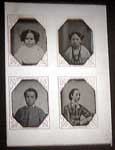 |
 |
 |
 |
 |
 |
 |
 |
 |
 |
 |
 |
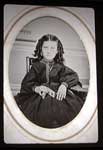 |
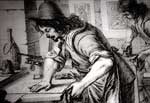 |
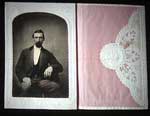 |
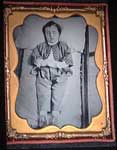 |
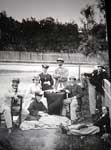 |
 |
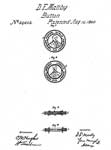 |
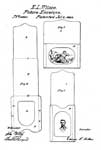 |
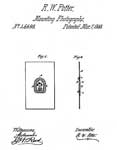 |
 |
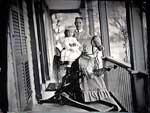 |
 |
 |
 |
ABOUT THE IMAGES. Hover over any image and a title will appear. Click on any image and in a few seconds you will see an enlarged view in a separate window. Close the window when you return to this page.
The images were captured from the screen during the slide show using a Nikon 990 digital camera and adjusted and sized in Photoshop. Some fuzziness is due to my impromptu tripod -- a chair back. The patent images are from the USA patent office at www.uspto.gov. Thanks to Werner Drechsel for directing us to this site.
Bob Carter